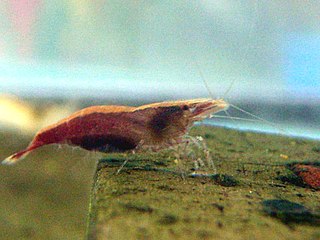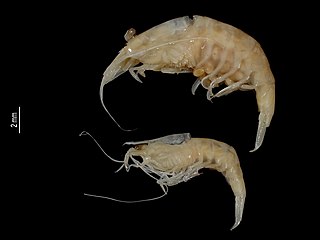
Caridina multidentata is a species of shrimp in the family Atyidae. It is native to Japan and Taiwan. Its common names include Yamato shrimp, Japanese shrimp, Amano shrimp, and algae shrimp.

Caridina serratirostris is a species of freshwater shrimp that lives in the Indo-west Pacific region, from Madagascar to Fiji, including northern Queensland, Australia, which may be a different subspecies. Its common name in the aquarium trade, "ninja shrimp", comes from its ability to quickly change colour and disappear into its surroundings like a ninja. Adults grow to a length of 25–35 millimetres (1.0–1.4 in).

Caridina gracilirostris is a species of brackishwater shrimp belong to genus Caridina in the family Atyidae. It has a wide native range extending from Japan and Fiji through Indonesia to Madagascar. It is an algae-eating species that lives in mangroves and marshes. Its common names include red front shrimp, red rhinoceros shrimp, red nosed phantom shrimp, and needlenose caridina, red nosed shrimp.

Caridina nilotica is a species of freshwater shrimp in the family Atyidae. It is native to Africa from the River Nile in Egypt to Lake Sibaya, South Africa, and is the only species of shrimp in Lake Victoria.

Caridina dennerli is a small species of freshwater shrimp from Sulawesi (Indonesia) that grows up to 2.5 centimetres (1.0 in) in length. It takes its name from the German company Dennerle, which supported the expedition that led to the scientific description of the species. It is popularly known as the 'Cardinal Shrimp' in the aquarium trade.

Caridina cantonensis, the bee shrimp, is a species of small freshwater shrimp in the family Atyidae. It is native to Taiwan. These shrimp are scavengers, and eat small pieces of decayed vegetation and algae. Bee shrimp have a life span of about 18 months. They enjoy a temperature in the 70 to 78 °F range. Many modern versions of bee shrimp are selectively bred for their characteristics.
Dennerle is a German company producing aquarium and pond supplies.
Caridina spongicola is a small species of freshwater shrimp from Sulawesi (Indonesia) that reaches 0.64 to 1.27 cm in length. In the wild it strictly lives on an undescribed species of freshwater sponge, making it one of only two known commensal species of freshwater shrimp. It is popularly known as the harlequin shrimp, and also sometimes Celebes beauty shrimp or sponge shrimp in the aquarium trade. It is often confused with Caridina woltereckae, a larger and more contrastingly colored species found in the same region as C. spongicola.

Caridina woltereckae, or Sulawesi harlequin shrimp as it is commonly known in the aquarium hobby, is a freshwater shrimp from Sulawesi, Indonesia. It is endemic to Lake Towuti. It resembles the smaller and less contrastingly coloured Caridina spongicola, which is endemic to the same lake.
Caridina striata is a freshwater shrimp from Sulawesi. It is endemic to Lake Poso and Lake Towuti. Common names in the aquarium hobby are red line shrimp and red stripe shrimp. It is commonly found on rocky substrates.
Caridina spinata, or Yellow goldflake as it is commonly known in the aquarium hobby, is a freshwater shrimp from Sulawesi. It is endemic to Lake Towuti. It lives on rocky substrates.
Caridina ensifera is a freshwater shrimp from Sulawesi. It is endemic to Lake Poso. It lives on a variety of substrates, including wood, rocks, sand and macrophytes, but is also found in pelagic swarms. It is suspected to only live in shallow water.
Caridina caerulea is a freshwater shrimp from Sulawesi. It is endemic to Lake Poso. It lives on a variety of substrates, including wood, rocks, sand and macrophytes. It is suspected only to live in shallow water.

Caridina loehae is a freshwater shrimp from Sulawesi. It is known as mini blue bee and orange delight shrimp in the aquarium trade. It is endemic to the Malili lake system. It lives on rocky substrates at a maximal depth of 5 metres.
Caridina yunnanensis is a freshwater shrimp from Xundian and Songming Counties, Yunnan, China. It is known to live in mountain streams and reservoirs.
Caridina masapi is a freshwater shrimp from Sulawesi. The species is endemic to the Malili lake system. It is commonly found on rocky substrate.
Caridina semiblepsia is a cave dwelling freshwater shrimp from China. It is only known from one location: the Baojing Cave in the provence of Hunan.
Caridina apodosis is a species of freshwater shrimp in the family Atyidae endemic to a mountain stream near the village of Tai Tong, China. Caridina apodosis is known from only the type series, collected in 1994. The exact type locality is unknown, and may be completely overtaken by urban sprawl. Caridina apodosis is assessed as Critically Endangered by the IUCN under criterion B1ab(iii)+2ab(iii) with the caveat 'possibly extinct'. C. apodosis is threatened by extensive water pollution as a result of urbanization, and the type locality may be unsuitable for inhabitance.

Caridina linduensis is a species of freshwater shrimp in the family Atyidae, endemic to Lake Lindu and its effluent stream in Sulawesi. It was known only from the type series, collected in 1904, and was recorded again in 2011 in a survey around Lake Lindu and is found in shallow littoral habitats of leaf litter, macrophytes, and dead wood. In the effluent stream it is found on soft substrates and slow flowing water, and is less common in the lake itself. The type locality of Lake Lindu was designated as a Recreation Park in 1978, and is part of the larger Lore Lindu National Park and UNESCO Biosphere Reserve. It is listed under IUCN criterion B1ab(iii,v) as Critically Endangered due to threats from introduced species of fish, land conversion to agriculture, logging, and shore disturbance caused by the grazing of water buffalo. Surveys are required to find the full distribution of C. linduensis, primarily its habitat in the effluent stream. C. linduensis is also sympatric with the recently described species Caridina dali and Caridina kaili.










